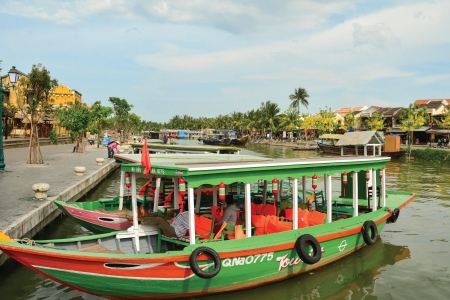ECO TOUR – HOI AN BY NIGHT









Hoi An not only offers tourists the charming beauty of the ancient town but also gives a chance to emerge into the daily life of local famers in rural villages around. Located 7 km from Hoi An’s Old Town, Cam Thanh Village is a village of 30ha nipa palm forest. Recently, Cam Thanh village has become a favorite spot for visitors because of its vast and beautiful water coconut palm forest.
Pick up at the hotel and heading to Cam Thanh village
First, our guide will give you a brief introduction to the village’s history. In the past the village used to be a base for the army and the people of Hoi An in the two wars against the French and the Americans.
Then, get on a bamboo basket-boat with a life jacket. Learn to paddle the unique Vietnamese bamboo basket-boat through the small and beautiful channels, and join in a basket-boat race (at least 2 boats). Join the local fishermen on the river and enjoy hands-on experience of round-net and cast-net fishing. You will have a chance to see unique basket boat dancing performed by local people.
Explore and go fishing and catch crab, coconut mussels and make lovely souvenirs from coconut leaves such as: rings, bracelets, hats…
Then, we take the boat and move down the Thu Bon River to The Old Town ( 1 hour ). On the boat, you can see the mouth of river and enjoy the beauty of the scenic on both riverside.
After arriving in the harbour, we continue to explore The Old Town
For centuries Hoi An was an important meeting place of many cultures, such as Champa, Vietnamese, Portuguese, Japanese and Chinese, and has been greatly impacted by Vietnamese and Chinese civilization. The town used to harbor foreign traders back in the 17-18th centuries, and it was an important heavily-frequented trading port in Southeast Asia. It was the busiest trading port in Dang Trong region of Vietnam during the reign of Nguyen as merchants from Japan, China, Portugal, Spain and Holland often stopped to exchange and purchase commodities. Some of them came and went, but many settled in permanently and left their marks in the history of Hoi An.
Mixed together with Vietnamese design Chinese and Japanese accents melt in and create a picture-perfect Hoi An of the late 19th century, which has remained mostly intact since. The end product is an oddly strange-yet-familiar sight that exists nowhere else in the world.
Apart from cultural values reflected by architectural buildings, Hoi An has kept a vibrant culture with a lot of intangible heritage. Everything in the ancient town, from daily life of the locals to traditions, customs and religious practices has been preserved and promoted well. That’s why Hoi An is called a living museum of architecture and way of city life.
In 1999, UNESCO formally recognized Hoi An as a World Heritage Site. Hoi An is home to many temples, pagodas and ancient homes that bear its very unique mark. The density of such site is unlike any other in Vietnam.
As the only traditional port typical of Southeast Asia in Vietnam, Hoi An has preserved many architectural buildings such as houses, assembly halls, communal houses, pagodas, temples, etc.
The ancient town is the best place for foreign tourists who want to understand and learn more about the lives, tradition and customs that people in distant feudalistic period had. Besides, a lot of handicrafts, souvenirs and top quality handmade clothes are also offered in Hoi An. A really good chance to bring back home the most beautiful gifts ultimately reflecting Vietnamese culture, identity and uniqueness from a memorable trip to a fascinating destination.
Finally, we have time to explore The Old Town by night with beautiful lanterns & night market (if the tour starts in the afternoon )
End the tour at your hotel
